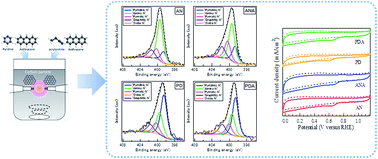Synthesis of graphitic-N and amino-N in nitrogen-doped carbon via a solution plasma process and exploration of their synergic effect for advanced oxygen reduction reaction†
Abstract
We present an alternative way to fabricate a N-doped carbon matrix via a room temperature solution plasma process. The type of C–N bonding states was controlled by choosing the structure of the original precursor and additive. In this research, pyridine and acrylonitrile were employed as the heterocyclic and linear structure precursor respectively. A small amount of anthracene (7 mM) was introduced as an additive to further promote the graphitic structure in the carbon matrix. The effects of the structure of the CN precursor on the chemical bonding states and electrocatalytic activities were investigated. The most pronounced peak was pyridinic-N when pyridine was applied as the precursor, whereas the dominant peak shifted to amino-N when the precursor changed to acrylonitrile. Furthermore, graphitic-N increased 30–40% when anthracene was added to the original precursors. From the results of electrochemical measurements, the current density was proportional to the content of graphitic-N, while a higher percentage of amino-N shifted the ORR onset potential to more positive values. N-doped carbon with the highest graphitic-N content showed the highest electron transfer number of 3.7 and the lowest peroxide yield of 30%. In contrast, N-doped carbon consisting of dominant pyridinic-N resulted in the lowest current density, ORR onset and peak potentials. The results indicated that the presence of graphitic-N encouraged a direct four electron transfer pathway for ORR. Herein, our research showed a room temperature solution method to control the chemical bonding states of nitrogen through designing the original precursors for the first time, as well as reports the synergic effect of amino-N and graphitic-N towards advanced ORR activity.



 Please wait while we load your content...
Please wait while we load your content...